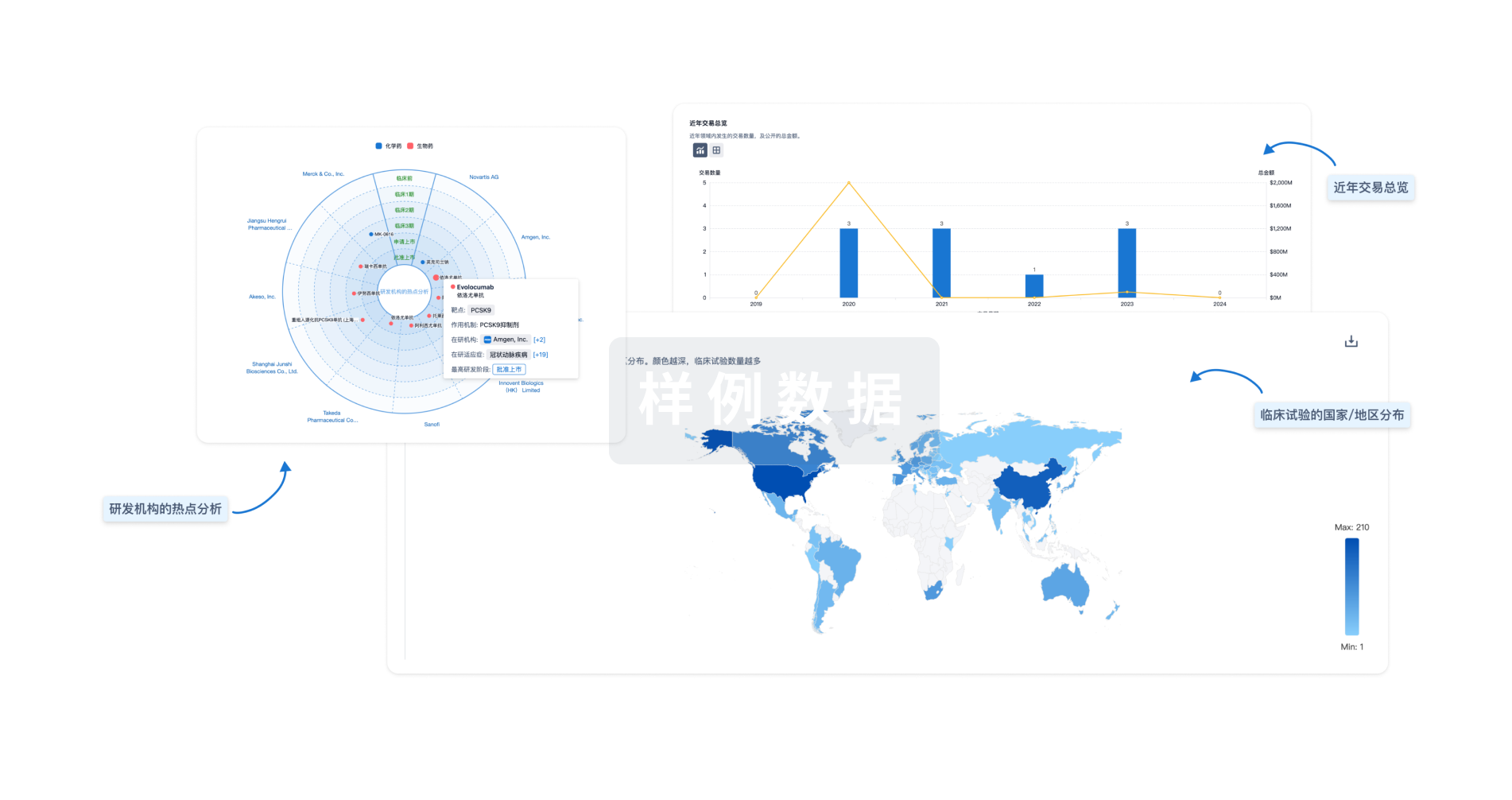预约演示
更新于:2025-05-07
SNAP29
更新于:2025-05-07
基本信息
别名 CEDNIK、SNAP-29、SNAP29 + [4] |
简介 SNAREs, soluble N-ethylmaleimide-sensitive factor-attachment protein receptors, are essential proteins for fusion of cellular membranes. SNAREs localized on opposing membranes assemble to form a trans-SNARE complex, an extended, parallel four alpha-helical bundle that drives membrane fusion. SNAP29 is a SNARE involved in autophagy through the direct control of autophagosome membrane fusion with the lysososome membrane. Also plays a role in ciliogenesis by regulating membrane fusions. |
关联
100 项与 SNAP29 相关的临床结果
登录后查看更多信息
100 项与 SNAP29 相关的转化医学
登录后查看更多信息
0 项与 SNAP29 相关的专利(医药)
登录后查看更多信息
209
项与 SNAP29 相关的文献(医药)2025-06-01·Cell Insight
Corrigendum to “STING guides the STX17-SNAP29-VAMP8 complex assembly to control autophagy” [Cell Insight 3 (2024) 100147]
作者: Lai, Ying ; Ding, Xia ; Liu, Siqi ; Li, Yunze ; Song, Xiaoyu ; Du, Shihao ; Liu, Xing ; Dai, Ming ; Xi, Yufeng ; Li, Mengjie ; Yao, Xuebiao ; Li, Tao ; Zhu, Yuxin
2025-05-01·British Journal of Pharmacology
Discovery of a potent inhibitor of chaperone‐mediated autophagy that targets the HSC70–LAMP2A interaction in non‐small cell lung cancer cells
Article
作者: Kong, Ling‐Yi ; Han, Liang‐Liang ; Yin, Yong ; Wei, Rong‐Yuan ; Qin, Cheng‐Jiao ; Xia, Yuan‐Zheng ; Wang, Kai‐Di ; Dong, Rui‐Fang ; Xiao, Cheng‐Mei
2025-03-01·Phytomedicine
Saikosaponin D exacerbates acetaminophen-induced liver injury by sabotaging GABARAP-SNARE complex assembly in protective autophagy
Article
作者: Sun, Rong ; Liu, Runping ; Wang, Le ; Zheng, Qi ; Xue, Xiaoyong ; Luo, Ranyi ; Fan, Guifang ; Duan, Shuni ; Li, Xiaojiaoyang ; Chen, Ranyun ; Li, Fanghong
2
项与 SNAP29 相关的新闻(医药)2024-10-13
·生物探索
引言
DNA 修复和自噬是维持细胞生存的两个关键生物学过程。DNA修复负责修复DNA损伤,确保基因组稳定;而自噬则负责清除细胞内多余的、受损的、错误折叠或聚集的蛋白质和细胞器,维持细胞稳态。拓扑异构酶 I (TOP1) 在DNA复制和转录中起着至关重要的作用,它通过切断DNA形成超螺旋结构,释放扭转应力。然而,TOP1与DNA形成的共价键——TOP1cc是一种有害的DNA损伤,会导致基因组不稳定和细胞死亡。TOP1cc修复主要依赖于酪氨酸DNA磷酸二酯酶 1 (TDP1) 介导的切除修复或MRE11核酶介导的DNA切割和切除修复【1】。然而,TOP1cc的修复过程与蛋白质降解途径的关系尚不清楚。自噬因子在DNA复制叉附近富集,表明自噬可能在DNA损伤修复中发挥作用。TEX264是一种保守的蛋白质,既是自噬受体,也与TOP1cc修复有关【2】。然而,TEX264是否通过自噬介导TOP1cc修复,目前尚不清楚。
近日,来自英国牛津大学拉德克利夫医院的Kristijan Ramadan研究团队在Cell杂志上发表题为TEX264 drives selective autophagy of DNA lesions to promote DNA repair and cell survival的研究论文,该研究发现了TEX264介导的核吞噬作用在维持基因组稳定性和细胞存活中发挥关键作用。
首先通过免疫共沉淀和蛋白质组学分析,研究人员发现自噬相关蛋白(如Beclin-1、TEX264、CHMP7、ATG7、SNAP29)在DNA复制叉处富集,并且这种富集在CPT(诱导DNA复制压力的化合物)处理后被显著增强,这表明自噬可能在响应 DNA 复制压力时发挥作用。接着,研究人员使用LysoIP技术分离溶酶体,并通过质谱分析其蛋白质组成。结果表明,CPT 处理后,许多DNA复制和核蛋白(如DNA聚合酶、MCM复合物蛋白、核孔复合物)被运送到溶酶体,表明溶酶体可能直接参与 DNA 损伤的清除。
进一步,研究人员发现用CPT处理后,TOP1cc水平的恢复受到mTOR抑制剂Torin的促进,而自噬抑制剂ATG7的缺失则完全阻止了TOP1cc的修复,证明自噬是TOP1cc修复的关键途径。其他自噬相关蛋白,如syntaxin 17和RB1CC1,也参与了TOP1cc的降解和细胞对CPT的存活,说明自噬修复TOP1cc的过程是一个复杂的网络,涉及多个自噬相关蛋白。使用mCherry-TOP1-GFP报告系统证实了TOP1在低剂量CPT处理后进入溶酶体,表明 TOP1cc可以直接被溶酶体降解。
通过分析γ-H2AX 和53BP1的定位,研究人员发现低剂量CPT诱导的DNA损伤主要表现为复制压力,而不是DNA 双链断裂。此外,研究人员发现ATR抑制剂VE-822强烈抑制了TOP1cc的运送,而ATM抑制剂KU-55933没有影响,这表明ATR在响应DNA复制压力和促进 TOP1cc 降解中起着关键作用。自噬抑制剂ATG7和syntaxin 17的缺失加剧了低剂量 CPT 处理后蛋白质聚集物的形成,说明自噬在防止蛋白质聚集物形成中发挥作用。
最后,研究人员发现MRE11核酶的缺失强烈抑制了TOP1cc的运送,而MUS81和TDP1的缺失没有影响,表明MRE11核酶在将TOP1cc从核内运送到溶酶体中起着关键作用。使用 LysoIP-Seq技术分离溶酶体中的DNA片段,并通过测序分析其序列特征。结果表明,溶酶体中分离的DNA片段主要来自核内 DNA,且大部分来自内含子和着丝粒区域,表明溶酶体可以清除整个TOP1cc损伤,包括其蛋白质部分和相关的DNA片段。使用 TOP1cc 特异性抗体和LysoIP等技术证实了TOP1cc在低剂量CPT处理后在细胞质中的存在。这表明 TOP1cc可以从核内被运送到细胞质,并被溶酶体降解。
图1 TEX264驱动的选择性自噬促进DNA修复和细胞存活(Credit: Cell)
总之,这项研究证明了选择性自噬在DNA修复中的进化保守作用,并表明它对维持基因组稳定性和细胞存活至关重要。此外,该发现还表明,在治疗结直肠癌患者时, TEX264的表达水平与对伊立替康等TOP1抑制剂的化疗反应相关。
参考文献
1. Pommier, Y. (2006). Topoisomerase I inhibitors: camptothecins and beyond. Nat. Rev. Cancer 6, 789–802. https://doi.org/10.1038/nrc1977.7. Stingele, J., Bellelli, R., and Boulton, S.J. (2017). Mechanisms of DNA–protein crosslink repair. Nat. Rev. Mol. Cell Biol. 18, 563–573.
2. Fielden, J., Wiseman, K., Torrecilla, I., Li, S., Hume, S., Chiang, S.-C., Ruggiano, A., Narayan Singh, A., Freire, R., Hassanieh, S., et al. (2020). TEX264 coordinates p97- and SPRTN-mediated resolution of topoisomerase 1-DNA adducts. Nat. Commun. 11, 1274.
https://www.cell.com/cell/fulltext/S0092-8674(24)00911-5
责编|探索君
排版|探索君
文章来源|“BioArt”
End
往期精选
围观
一文读透细胞死亡(Cell Death) | 24年Cell重磅综述(长文收藏版)
热文
Cell | 是什么决定了细胞的大小?
热文
Nature | 2024年值得关注的七项技术
热文
Nature | 自身免疫性疾病能被治愈吗?科学家们终于看到了希望
热文
CRISPR技术进化史 | 24年Cell综述
2023-06-20
·生物谷
自噬是细胞中的一种“自噬”现象,自噬小体包裹错误折叠的蛋白质或受损的细胞器,随后与溶酶体融合形成自溶酶体。被包裹的内容物被自溶酶体降解,以实现细胞内环境的稳定和细胞器的更新。
自噬是细胞中的一种“自噬”现象,自噬小体包裹错误折叠的蛋白质或受损的细胞器,随后与溶酶体融合形成自溶酶体。被包裹的内容物被自溶酶体降解,以实现细胞内环境的稳定和细胞器的更新。根据自噬的发生过程,自噬可分为巨型自噬、伴侣介导型自噬和微型自噬。
其中,CMA是一种选择性的以Lys-Phe-Glu-Arg-Gln(KFERQ)样五肽基序为靶向的蛋白质降解自噬。KFERQ类基序要么存在于初级氨基酸序列中,要么通过翻译后修饰产生,如磷酸化或乙酰化。
胞内伴侣热休克同源蛋白70(HSC70)可以识别含有KFERQ样基序的底物蛋白,随后底物-伴侣复合体通过与溶酶体膜蛋白2A型(LAMP2A)结合转移到溶酶体膜上,并驱动LAMP2A型多聚体形成易位复合体,底物通过该复合体进入溶酶体进行降解。
图片来源:https://pubmed.ncbi.nlm.nih.gov/37311689/
近日,来自中国药科大学的研究者们在Br J Pharmacol杂志上发表了题为“Discovery of a potent inhibitor of chaperone-mediated autophagy that targets the HSC70-LAMP2A interaction in non-small cell lung cancer therapy”的文章,该研究揭示了PPD是一种靶向CMA抑制剂,可以阻断HSC70LAMP2A相互作用和LAMP2A同源多聚化。抑制CMA而不增加巨噬细胞自噬的调节补偿是非小细胞肺癌治疗的好策略。
伴侣介导的自噬(CMA)是一种选择性的针对蛋白质降解的自噬,在多种恶性肿瘤中保持高活性。抑制HSC70和LAMP2A的结合可以有效地阻断CMA。目前,抑制CMA的最具特异性的方法仍然是下调LAMP2A,目前还没有发现抑制CMA的化学抑制剂。
用酪胺信号放大(TSA)双免疫荧光法检测NSCLC组织中CMA的表达水平。根据CMA活性进行高含量筛选,以确定潜在的CMA抑制剂。通过药物亲和反应靶标稳定性-质谱法(DARTS-MS)确定了该抑制剂的靶点,并用蛋白质质谱仪进行了验证。通过对CMA的抑制和激活来阐明CMA抑制剂的分子机制。
研究者发现,抑制HSC70和LAMP2A之间的相互作用可以阻断非小细胞肺癌中的CMA,并抑制肿瘤的生长。PPD通过干扰HSC70-LAMP2A相互作用首次被确定为CMA的靶向小分子抑制剂。
PPD的结合位点分别位于HSC70的核苷酸结合区E129和LAMP2A的C末端T278。PPD通过抑制HSC70-LAMP2a-eIF2α信号轴,加速蛋白质合成,诱导ROS积累。此外,PPD还通过阻断STX17-SNAP29-VAMP8信号轴,阻止了CMA抑制引起的巨噬细胞自噬的调节补偿。
图片来源:https://pubmed.ncbi.nlm.nih.gov/37311689/
PPD阻断非小细胞肺癌CMA的作用机制
综上所述,研究者首次报道PPD是非小细胞肺癌中CMA的靶向抑制剂。更重要的是,本研究为开发CMA抑制剂提供了新的策略。靶向抑制HSC70-LAMP2A相互作用或LAMP2A同源多聚化对非小细胞肺癌的治疗具有很强的疗效。(生物谷 Bioon.com)
参考文献
Rui-Fang Dong et al. Discovery of a potent inhibitor of chaperone-mediated autophagy that targets the HSC70-LAMP2A interaction in non-small cell lung cancer therapy. Br J Pharmacol. 2023 Jun 13. doi: 10.1111/bph.16165.

分析
对领域进行一次全面的分析。
登录
或

生物医药百科问答
全新生物医药AI Agent 覆盖科研全链路,让突破性发现快人一步
立即开始免费试用!
智慧芽新药情报库是智慧芽专为生命科学人士构建的基于AI的创新药情报平台,助您全方位提升您的研发与决策效率。
立即开始数据试用!
智慧芽新药库数据也通过智慧芽数据服务平台,以API或者数据包形式对外开放,助您更加充分利用智慧芽新药情报信息。
生物序列数据库
生物药研发创新
免费使用
化学结构数据库
小分子化药研发创新
免费使用